Fin Rot
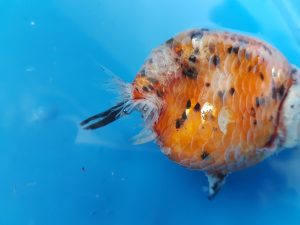 WHAT IS FIN ROT?
WHAT IS FIN ROT?
Fin Rot is where your goldfish fins looks torn and ragged. It may look like the chunk or slices or the fin is missing. Fin Rot may cause discoloration and even lethargic if it’s not treated properly.
THE CAUSE
There is several cause to it and the mast commonly – poor water quality and of course there are as well other cause which include fighting, rough handling and overcrowded tank.
Fish tank contains a lot of bacteria which normally don’t harm your fish. But when the water quality is poor, your fish become stress and lower down the immune system and in the same time if you have more “bad ” bacteria in the tank , the bacteria may tend to eat up the fins which cause the fin rot.
Fish with fin rot always scratch them with the tank furniture which may cause more damage as the wound may infected with other bacteria
SYMPTOMS
- split and ragged fins, sometimes with a white edge on it.
- red streaks on fins
TREATMENT
Isolated the affected fish and placed them in a clean container with clean water. Wash the tank and all accessories and not to forget to check the PH level to ensure water quality is good. PH should be around 7-8 and the ammonia, zero nitrites and nitrates should be no higher than 40 ppm.
If your fin rot doesn’t improve in a few days. Please use antibacterial treatment for e.g. Jungle Fungus Eliminator and Tetracycline. You can also use brands like Maracyn, Maracyn II, Waterlife- Myxazin, and MelaFix.Make sure the fin rot treatment does not contain any organic dyes, as they can be toxic to certain fish.
I find the following treatment works :
Day 1 – do an immediate 40% water change and examine all aquarium conditions. You may want to follow the 6-day treatment to cure this disease.
Premix these ingredients before adding to the main tank:
Pure rock Salt/sea salt: 1 tablespoon per 10 gallons
Epson salt: 1 teaspoon per 10 gallons
Melafix: 1/2 teaspoon per 10 gallons if pH not over 7.5
Combine salts into 1/4 cup of warm water to dissolve. Mix to dilute Melafix in a freshwater Bucket.
Replace only 5%(of fresh water) every 15 minutes to reduce the risk of shock. Add water treatment to the water you add to the tank to remove ammonia and chlorine.
Day 2 to 5 – you will repeat the following process:
- perform a 20% partial water change using the directions on 1st day
- add salt: 1 tablespoon per 10 gallons
- don’t forget to dilute and mix thoroughly in a 1 gallon of tank water before adding to the tank
Day 6 – you will be reversing the treatment by performing only water changes for 5 more days
Day 11 – repeat entire treatment but use only salt. If after 30 days signs of infection remain, start treatment again.
When you treat your sick fish , please ensure the oxygen level is high because medication tend to leech oxygen. Only with sufficient oxygen supply your fish can live healthily.
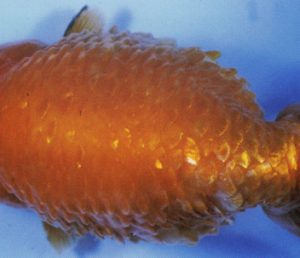 WHAT IS DROPSY?
WHAT IS DROPSY?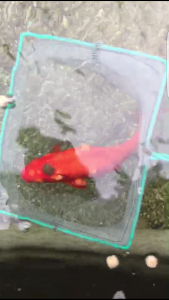 WHAT IS CARP POX?
WHAT IS CARP POX?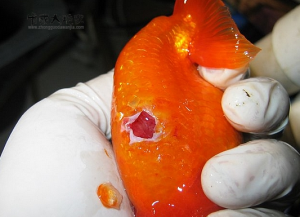 WHAT IS ULCER?
WHAT IS ULCER?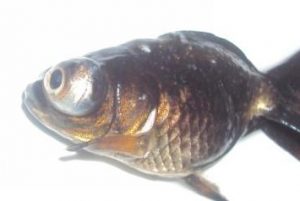 What is POP EYE?
What is POP EYE?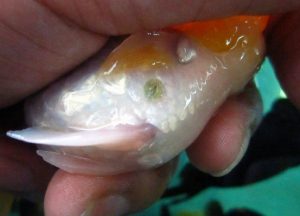 Lice and worms are quite common parasites in tank. Both of them rely on goldfish to thrive and reproduce which can potentially lead to health problem in your fish. Lice can usually reach up to 5mm in diameter and you can see them quite well without using a microscope. Don’t mistake them with algae or dirt. While worms, Anchor worms can be seen with naked eye on the fish body, while tapeworms are internal parasites, you may also see live or dead tapeworms in your fish’s stools, or hanging from the anus of the fish.
Lice and worms are quite common parasites in tank. Both of them rely on goldfish to thrive and reproduce which can potentially lead to health problem in your fish. Lice can usually reach up to 5mm in diameter and you can see them quite well without using a microscope. Don’t mistake them with algae or dirt. While worms, Anchor worms can be seen with naked eye on the fish body, while tapeworms are internal parasites, you may also see live or dead tapeworms in your fish’s stools, or hanging from the anus of the fish.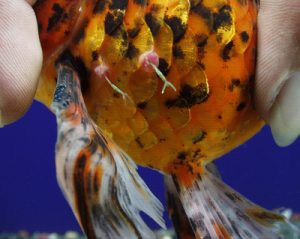 Lice and worms are both visible and can lead to serious health issue in your goldfish. Thus, identifying them is important before action taken. you may find the following symptom in your tank:
Lice and worms are both visible and can lead to serious health issue in your goldfish. Thus, identifying them is important before action taken. you may find the following symptom in your tank: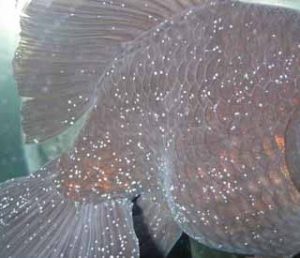 WHAT IS ICH a.k.a WHITE SPOT?
WHAT IS ICH a.k.a WHITE SPOT?
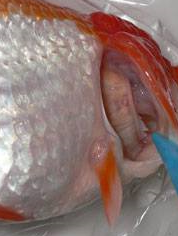 WHAT IS FLUKES?
WHAT IS FLUKES?